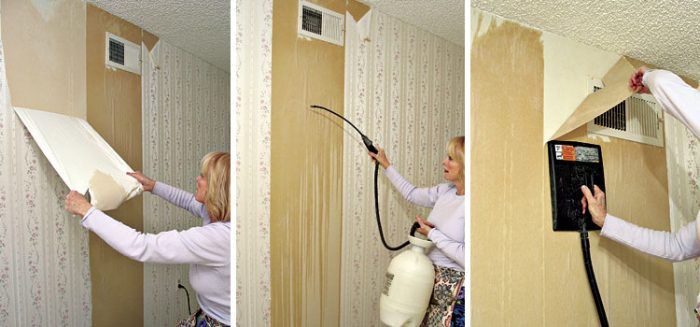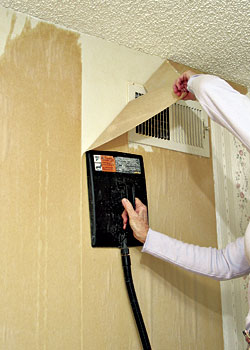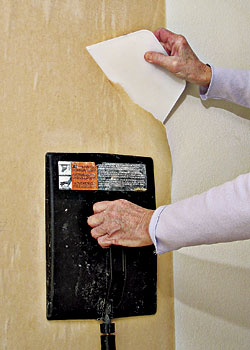Removing Old Wallpaper
Stripping old wall coverings is messy and time-consuming, but the right approach can help the job go more smoothly.

Fine Homebuilding founding editor Mike Litchfield explains the process in this excerpt from Renovation, 5th Edition (The Taunton Press, 2019).
Strip existing wallcovering if it is tired or grimy and can’t be washed, poorly adhered or damaged, puckered or lumpy because there are too many layers, water stained or damaged, moldy, strongly textured, or you want to paint the walls instead. Before you apply new wallcovering, repair and prime the finish surfaces.
Before stripping, reconnoiter. Peel up a corner of the wallpaper in an out-of-the-way place. Then determine whether the walls are plaster or drywall. Plaster is harder and can survive a lot more steaming and scraping than drywall. Next, test how easily the wallpaper strips. Peelable and strippable types should be relatively easy to remove if the wall was properly sealed before it was papered. But if surfaces were not sized or primed first, you’re in for some work. Moreover, if the unsealed substrate is drywall, stripping the wallpaper may destroy the paper face of the drywall. In theory, you can patch and then seal damaged drywall with products like Allpro Seal ‘n Bond“; but removing the damaged drywall, or covering it with 1/4-in. drywall will yield far better results.
Stripping wallpaper is messy, no matter what method you use. You’ll need painters’ tarps or old towels to protect floors from stripping solutions, condensed steam, and sticky wallpaper. Canvas tarps, or even old towels, are better than plastic tarps, which tend to be slippery. Have trash bags handy for stripped paper. As noted earlier, turn off the electricity to areas you’re stripping, and use a voltage tester to be sure the power’s off.
Use the least disruptive stripping method. Start stripping at the top or bottom of a strip. Use a putty knife or a plastic scraper to lift an edge. Then gently pull off the wallpaper, in the largest strips possible. This takes patience.
If you can’t pull off the covering or if it begins tearing into small pieces, try spraying a small area with a wallpaper-removing solution like Zinsser’s DIF, which is also available as a gel, that you brush on. A time-tested alternative is 1 cup vinegar per gallon of hot water; sponge on or apply with a spray bottle. Allow either solution to soak in 5 minutes to 10 minutes, before trying to pull off the paper. If this method doesn’t work, chances are the paper is vinyl coated and the solution is not penetrating. In this case, instead try a wallpaper steamer. Hold the steamer pan against the wallcovering long enough for the paste to soften—usually a minute or two—then pull or scrape the covering free.
If your wallcovering is peelable, chances are its facing layer will strip off, leaving its paper backing adhered to the wall. If you wish to strip it, either spray on or sponge on wallpaper-removing solution, and then apply steam. The backing should release easily; otherwise, use a plastic scraper or smoother to remove the backing. When the walls are stripped, wash them with a mild cleaning solution. Then rinse and let them dry thoroughly before applying a primer-sealer. If paste lumps remain, remove them with a nylon-bristle scrub brush.
Stripping takes patience. Start at one end of a strip, pulling slowly and steadily so that the strip comes off in a single piece, if possible. This covering was peelable, meaning that its facing peeled off, but its paper backing stayed stuck to the substrate.
 |
 |
 |
To remove the paper backing, spray it with a solution of hot water and a wallpaper-stripper such as DIF, which breaks down the paste. Allow the solution to soak in 3 minutes to 5 minutes. Because spraying is messy, place old towels or a tarp at the base of the wall.
Applying steam will hasten the penetration of the stripper solution and soften the paste, making removal easier. On this wall, heat from a nearby register had baked the paste hard.
A plastic wallpaper smoother-scraper will scrape off steamed paper backing without damaging drywall beneath. When all paper is off, use a soft-bristle nylon scrub brush to gently remove paste residue.
Scarifying Tool

Some pros recommend using a scarifying tool, such as Paper Tiger“, to perforate wallpaper so steam can penetrate. But such tools can also perforate drywall and scar its surface. Damage can also occur if you use metal-edged scrapers. So use such tools only as a last resort when the paste is especially tenacious, and use them with great care. Instead, try steaming the wallpaper, before scarifying or scraping it.
Strippable vs. Peelable
Strippable wallcovering can be dry stripped (no spraying or steaming needed); both the facing and the backing material come off easily, with only a faint paste residue left on the wall. Peelable coverings usually require spraying with a wallpaper-removing solution or steaming to remove the wallpaper facing. If the paper backing is in good shape, it can stay on the wall as a wall liner for the new wallpaper. Otherwise, remove it, too.
Michael W. Litchfield, one of the founding editors of Fine Homebuilding magazine, has been renovating houses or writing about them for more than 40 years. Photos by Michael Litchfield and Ken Gutmaker






